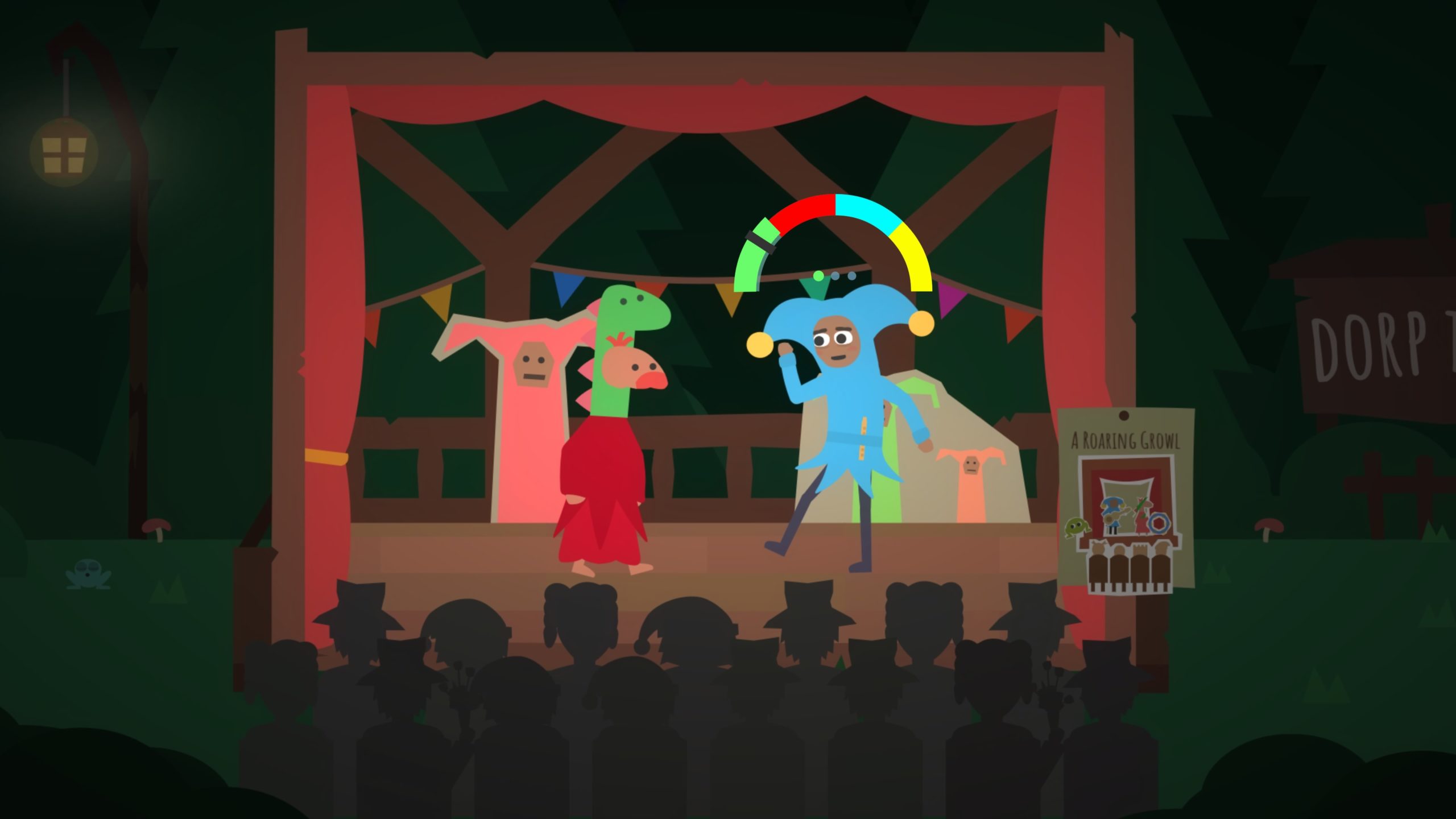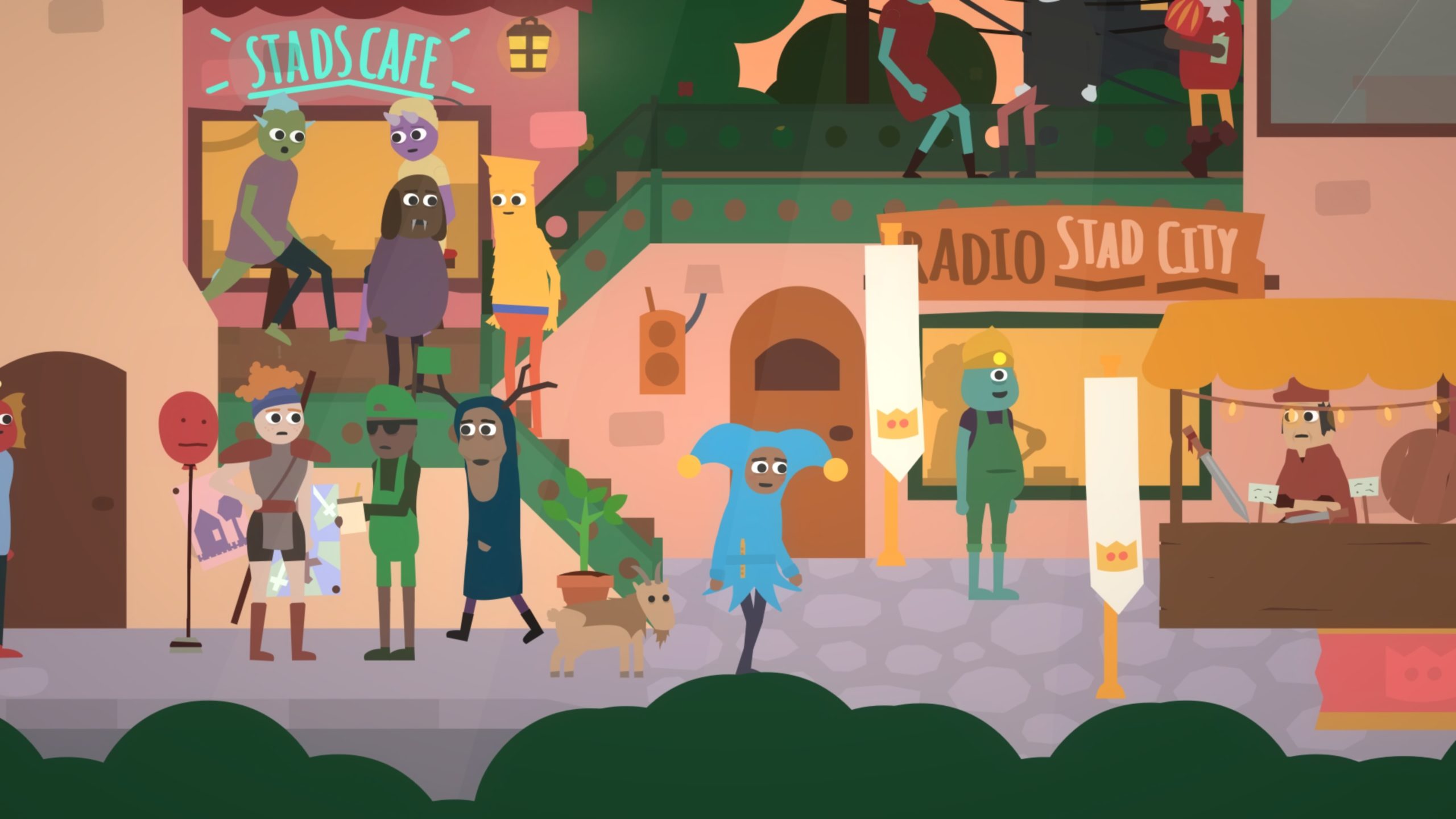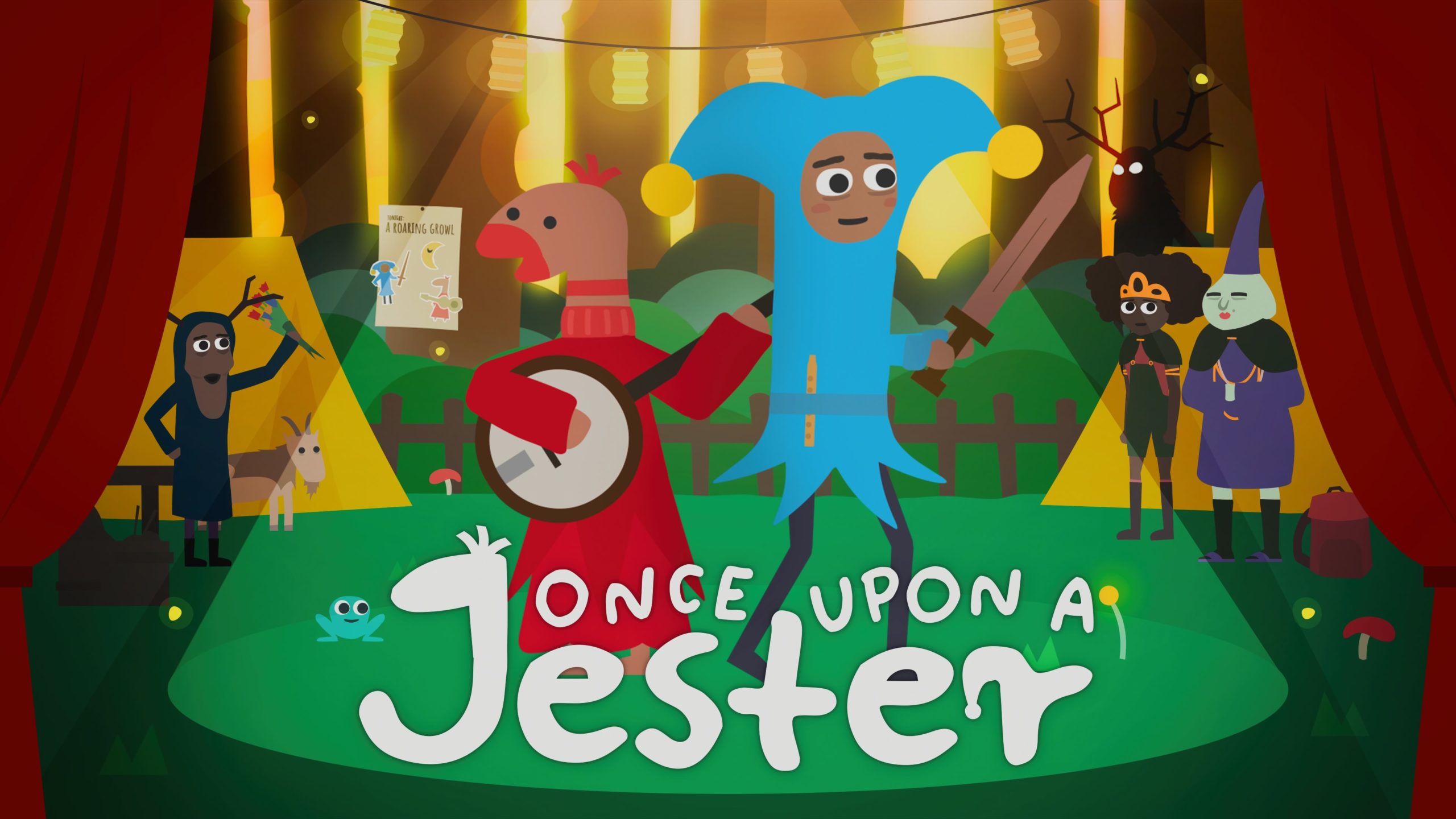As I type out the synopsis of Once Upon A Jester, I realise how much it sounds like a Peyote fever dream: “While dossing around Dorp Town, a pair of friends, a jester and a sentient sock man (Called Sok) hear of a contest being held by a Princess. The first troupe to receive 15 bouquets of flowers in each town of the land by performing stage shows will win a spot in a Royal show where they’ll perform in front of the King. The jester and the sock-person see this as an opportunity to get into the Royal castle and steal a giant diamond. So the roguish pair trot off on a musical adventure to get rich and inadvertently make friends along the way.“
While it might sound preposterous (oh, it is) Once Upon A Jester is as much whimsy, sharp wit, heartfelt moments and dry humour as it is absurdism. In a gaming landscape that’s packed with grim-dark tragedies and Cyberpunk violence, the happy-go-lucky journey of Jester and Sok is deeply refreshing.
The Whole World’s A Stage
Mechanically, Once Upon A Jester plays like a 2D adventure game. You control the titular Jester and move him around various small environments. Here, he can interact with items in the world and converse with the characters he meets, indicated with an exclamation point floating above their head.
Very quickly, the game settles into a play cycle that lasts for the vast majority of the game. You’ll either wake up in, or travel too, one of the environments, and you’ll set off to explore. During this exploration, you’ll get the chance to determine what kind of stage show will please the audience the most that evening. This can be determined by watching for symbols that show above NPC’s heads when close enough to eavesdrop their conversations, on posters in the world, and by the merchandise that is being sold for the show.
Once you’ve determined what type of show will woo the audience, you must then pull together a show poster. Using an array of backgrounds and stickers you can unlock via myriad ways during play, you can design the poster however you see fit. While this has no material impact on success or failure (Disclaimer: there is no failure conditions in Once Upon A Jester, but there are less desirable outcomes), it’s a nice little creative diversion that adds to the overall experience.

Once you’re happy with your poster, you can then speak to Sok and start the show. During Once Upon A Jester, you’ll be able to perform three different plays, and each and every one can be tailored to the audience. During multiple junctures in each show, you can improvise the tone from a selection that is show on screen. For example, if you’ve determined that your audience will enjoy an action packed show that night, you can select options with a green sword icon that will trigger an action sequence. If the audience is into scary shows, you can choose options with an orange spider icon to amp up the frights.
Every choice you make during these shows triggers a mini-game. A coloured half-circle dial is used for each and every one of these mini-games, but each is used in a subtly different way. In mini-games for action sequences, you might be tasked with button mashing while the dial’s arrow is over a highlighted section. During musical mini-games, you could be playing a memory game that tests you to mimic the colours that Sok plays out. These mini-games are all rudimentary, but are instantly intuitive, resulting in a low stress yet continually engaging affair.
At the end of the show, you’ll be rewarded with those coveted bouquets of flowers. The number of bouquets you’ll receive will correspond to how well you’ve pitched the tone of the show, choosing the right options to suit the audiences taste, as well as how well you perform in the mini-games. Once you’ve earned 15 in a town (a minimum of 3 stage shows), you can then head off to the next town, and the next part of the story.

Get The Show On The Road
As you progress around the various towns of Once Upon A Jester, you’ll gradually open up a a heartfelt yet irreverent narrative that focuses on an ever widening main cast. Each new location introduces a few more characters, some of which contribute a few gags to Sok & Jester’s adventure before leaving, while others come along for the ride.
All of the conversations in the game are fully voiced, and the blithe script is equal parts relatable and eccentric. For every moment of Jester & Sok delivering deadpan lines of comedy gold in a glorious dutch accent, there is a complementary moment where they act shocked by the absurdity of the world around them. The biggest complement I can give to Once Upon A Jester is that it feels like it was written and produced by a group of friends that are just having a laugh with one another, and they’re letting you in on the joke. I caught myself smiling more than a few times at the wit, the happenstance and the in-jokes that persist throughout the game. Not every joke landed with me, but the vast majority did.
Which brings us to the strongest element of Once Upon A Jester – the music. The game occasionally feels like an episode of Glee. You’ll be chatting with a bunch of characters and then suddenly, music will start and you’ll be treated to a short song. As you might expect from a team that are as much musicians as they are game developers, the music is fantastic. I’ve been listening to the soundtrack as I write this review, and it’s full of little ear-worms that I’d happily listen too on repeat. Tracks like ‘For Bettely Beth’ have me bopping my head for the whole of its 24 second length, while the beautiful ‘Ferris Wheel’ sets a far more gentle, fragile tone complete with empowering lyrics. My favourite track in the game is ‘Wendy The Wendigo’ which has a little bit of everything.

Time In The Limelight
The Once Upon A Jester developers Bonte Avond have been cornering an art style of their own that runs like veins through their games. Like ‘Tower Guy’ and ‘Everybody Wham Wham’ before it, the art style here is full of bold, colourful shapes, minimalistic detailing and anthropomorphic people. This art style acts as the base from which the abstract and absurdist tone of the rest of the game is built. It works effectively and presents a storybook-come-to-life look.
While it’s pleasing on the eye, this art style can look a little muddled when the screen is busy. As characters and the environment have no outline, it can be difficult to make out where things or people begin and end. It doesn’t happen often, as the game is careful to space things out, but there are a few times when the screen is crowded and you can easily interact with the wrong thing or person on accident.
The only other shortcoming of Once Upon A Jester in my opinion is with the complexity of the mini-games during the stage shows. It’s clear that these mini-games have been crafted with accessibility in mind, and that’s an admirable approach. This does however mean that these mini-games are very easy. Having a separate difficulty mode with more challenging mini-games might have allowed for the accessibility where necessary, but would have made the challenge of earning the 15 bouquets of flowers feel more of an accomplishment.
All considered, Once Upon A Jester is a bright and breezy musical adventure that stands out from the crowd. It has the tools to make you laugh, the music to make you nod your head and a general chill, fun time vibe that’s rare in gaming these days. If you like point and click adventures like Sam & Max Adventures, or music-centric games like The Artful Escape, you’ll have a blast with Once Upon A Jester.
Once Upon A Jester is available now on PlayStation 5 (review platform), PC and Xbox Series X|S.
Developer: Bonte Avond
Publisher: Crunching Koalas
Disclaimer: In order to complete this review, we purchased a copy of the game. For our full review policy, please go here.
If you enjoyed this article or any more of our content, please consider our Patreon.
Make sure to follow Finger Guns on our social channels –Twitter, Facebook, Twitch, Spotify or Apple Podcasts – to keep up to date on our news, reviews and features.
